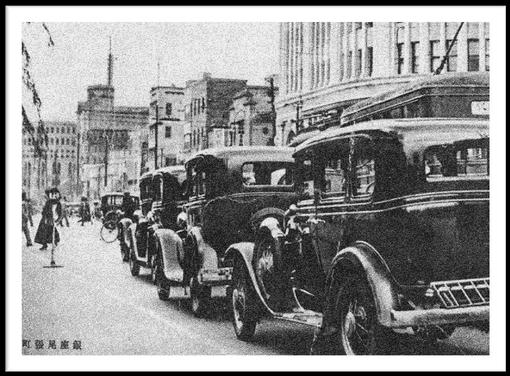Ginza Postcard 1932
Postcard (front)
Postcard (back)
Source: Postcard from photo in Shufu no tomo (Homemaker’s Friend) magazine, September 1, 1932. (c. James Huffman)
Context.
Japan’s postal service, launched in 1872, quickly became one of the largest and most efficient mail delivery systems, handling a billion pieces of mail a year by the early 1900s and developing the world’s largest postal savings system. Picture postcards were an important part of the mails after 1900, when the post office allowed private firms to begin producing cards. From that time on, it was popular to both send and collect these cards, with their photos providing a snapshot of the way people saw life. While historians looking at Japan in 1932 often focus on growing militarization since this was the year in which Japan created the puppet state of Manchukuo in northeast China and launched its expansion onto the Asian continent, the postcard photograph here of Tokyo’s major commercial district, the Ginza, shows a different side of Japan’s scene: booming middle class life. Military control may have been spreading; waves from the Great Depression may have continued to roll in; but as these buildings and automobiles suggest, by 1932 Japan had returned to relative economic prosperity. The large white building in the foreground was the newly renovated Hattori Clock Store; that on the left side of the card was the headquarters of the newspaper giant Tokyo Asahi Shimbun.
Questions.
1. If you knew nothing more about Japan in 1932 than what you see in this postcard, how would you describe the country?
2. What signs does this card give of the modernization and internationalization of Japan in the years between the two world wars?
3. Why is the tale that this photo tells different from the story of military expansion that dominates standard histories of this period?
Terms.
Manchukuo. Although Japan had made major economic and military investments in northeast China, or Manchuria, since the early twentieth century, the region remained part of China until a military incident in the city of Mukden (Shenyang) in September 1931 prompted Japan to send in more troops and tighten its control. In February 1932, a puppet state called Manchukuo was proclaimed under Japanese domination.
Great Depression. The Japanese, like people everywhere, were rocked by the worldwide depression in 1929-30. But under the policies of Finance Minister Takahashi Korekiyo—particularly currency devaluation, which made Japan’s goods cheaper for sale abroad, and deficit spending—Japan returned to financial health more quickly than most other nations.
Postcard (back)
Source: Postcard from photo in Shufu no tomo (Homemaker’s Friend) magazine, September 1, 1932. (c. James Huffman)
Context.
Japan’s postal service, launched in 1872, quickly became one of the largest and most efficient mail delivery systems, handling a billion pieces of mail a year by the early 1900s and developing the world’s largest postal savings system. Picture postcards were an important part of the mails after 1900, when the post office allowed private firms to begin producing cards. From that time on, it was popular to both send and collect these cards, with their photos providing a snapshot of the way people saw life. While historians looking at Japan in 1932 often focus on growing militarization since this was the year in which Japan created the puppet state of Manchukuo in northeast China and launched its expansion onto the Asian continent, the postcard photograph here of Tokyo’s major commercial district, the Ginza, shows a different side of Japan’s scene: booming middle class life. Military control may have been spreading; waves from the Great Depression may have continued to roll in; but as these buildings and automobiles suggest, by 1932 Japan had returned to relative economic prosperity. The large white building in the foreground was the newly renovated Hattori Clock Store; that on the left side of the card was the headquarters of the newspaper giant Tokyo Asahi Shimbun.
Questions.
1. If you knew nothing more about Japan in 1932 than what you see in this postcard, how would you describe the country?
2. What signs does this card give of the modernization and internationalization of Japan in the years between the two world wars?
3. Why is the tale that this photo tells different from the story of military expansion that dominates standard histories of this period?
Terms.
Manchukuo. Although Japan had made major economic and military investments in northeast China, or Manchuria, since the early twentieth century, the region remained part of China until a military incident in the city of Mukden (Shenyang) in September 1931 prompted Japan to send in more troops and tighten its control. In February 1932, a puppet state called Manchukuo was proclaimed under Japanese domination.
Great Depression. The Japanese, like people everywhere, were rocked by the worldwide depression in 1929-30. But under the policies of Finance Minister Takahashi Korekiyo—particularly currency devaluation, which made Japan’s goods cheaper for sale abroad, and deficit spending—Japan returned to financial health more quickly than most other nations.


